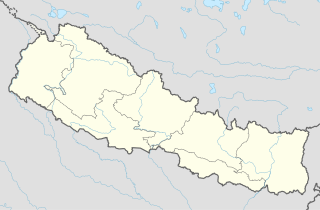
Amlekhganj (Nepali:अमलेखगंज) is a town and Village Development Committee in Bara District in the Narayani Zone of south-eastern Nepal. At the time of the 2011 Nepal census it had a population of 6,709 people living in 1370 individual households. There were 3,413 males and 3,296 females at the time of census. At one time it was famed as the starting point of the Nepal Government Railway (NGR) which connected it with Raxaul in India.

Babuain is a village and Village Development Committee in Bara District in the Narayani Zone of south-eastern Nepal. At the time of the 2011 Nepal census it had a population of 3,459 people living in 538 individual households. There were 1,778 males and 1,681 females at the time of census.

Badaki Phulbariya is a town and Village Development Committee in Bara District in the Narayani Zone of south-eastern Nepal. At the time of the 2011 Nepal census it had a population of 7,107 persons living in 904 individual households. There were 3,739 males and 3,368 females at the time of census.

Bahuari is a town and Village Development Committee in Bara District in the Narayani Zone of south-eastern Nepal. At the time of the 2011 Nepal census it had a population of 4,965 persons living in 646 individual households. There were 2,574 males and 2,391 females at the time of census.

Balirampur is a village and Village Development Committee in Bara District in the Narayani Zone of south-eastern Nepal. At the time of the 2011 Nepal census it had a population of 7,126 persons living in 1,014 individual households. There were 3,685 males and 3,441 females at the time of census.

Batara is a village and Village Development Committee in Bara District in the Narayani Zone of south-eastern Nepal. At the time of the 1991 Nepal census it had a population of 2,500 persons living in 411 individual households.

Benauli is a town and Village Development Committee in Bara District in the Narayani Zone of south-eastern Nepal. At the time of the 1991 Nepal census it had a population of 3,036 persons living in 486 individual households.

Bhagwanpur is a village and Village Development Committee in Bara District in the Narayani Zone of south-eastern Nepal. At the time of the 1991 Nepal census it had a population of 2,313 persons living in 418 individual households.
Bishwambharpur is a town and Village Development Committee in Bara District in the Narayani Zone of south-eastern Nepal. At the time of the 1991 Nepal census it had a population of 3,232 persons living in 491 individual households.
Brahmapuri is a town and Village Development Committee in Bara District in the Narayani Zone of south-eastern Nepal. At the time of the 1991 Nepal census it had a population of 3,326 persons residing in 491 individual households.

Dewapur is a village and Village Development Committee in Bara District in the Narayani Zone of south-eastern Nepal. At the time of the 2011 Nepal census it had a population of 4,716 persons living in 642 individual households. There were 2,432 males and 2,284 females at the time of census.

Gadhahal is a village and Village Development Committee in Bara District in the Narayani Zone of south-eastern Nepal. At the time of the 2011 Nepal census it had a population of 3,193 persons living in 545 individual households. There were 1,627 males and 1,566 females at the time of census.

Golaganj is a village and Village Development Committee in Bara District in the Narayani Zone of south-eastern Nepal. At the time of the 2011 Nepal census it had a population of 5,070 persons living in 729 individual households.There were 2,659 males and 2,411 females at the time of census.

Haraiya is a town and Village Development Committee in Bara District in the Narayani Zone of south-eastern Nepal. At the time of the 2011 Nepal census it had a population of 9,710 persons living in 1,714 individual households. There were 4,788 males and 4,922 females at the time of census.

Hariharpur is a town and Village Development Committee in Bara District in the Narayani Zone of south-eastern Nepal. At the time of the 2011 Nepal census it had a population of 5,458 persons living in 804 individual households. There were 2,832 males and 2,626 females at the time of census.

Manaharwa is a town and Village Development Committee in Bara District in the Narayani Zone of south-eastern Nepal. At the time of the 1991 Nepal census it had a population of 5,676 persons living in 947 individual households.
Piparpati Jabdi is a village and Village Development Committee in Bara District in the Narayani Zone of south-eastern Nepal. At the time of the 1991 Nepal census it had a population of 2,617.

Paterwa is a village and Village Development Committee in Bara District in the Narayani Zone of south-eastern Nepal. At the time of the 1991 Nepal census it had a population of 2,463 persons living in 465 individual households.

Pipradhi Goth is a town and Village Development Committee in Bara District in the Narayani Zone of south-eastern Nepal. At the time of the 1991 Nepal census it had a population of 3,530 persons living in 527 individual households. Pipradhi Goth is the second developed village in Bara District.

Sapahi is a town and Village Development Committee in Bara District in the Narayani Zone of south-eastern Nepal. At the time of the 1991 Nepal census it had a population of 7,209 persons living in 1275 individual households.





